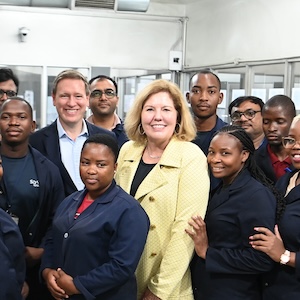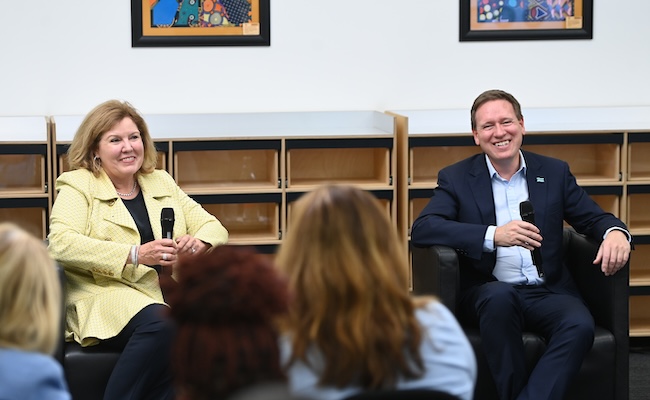
Signet Jewelers and De Beers are launching a joint campaign to promote natural diamonds, built around a new “beacon” product reminiscent of De Beers’ past efforts like the three-stone ring and Journey jewelry with graduated stones.
In a joint interview with JCK, Signet CEO Gina Drosos and De Beers CEO Al Cook didn’t give many specifics on the new product, which will go on sale in the third quarter. The two have selected an advertising agency to tout the product, and its marketing will be backed by an influencer campaign. Drosos says Signet is still deciding which of its banners—which include Kay, Zales, Jared, and Diamonds Direct—will carry the new line.
The two execs declined to put an overall monetary value on the venture, but Cook says it will likely top the $20 million De Beers spent last year on its “Seize the Day” program.
While the new brand is proprietary, Cook and Drosos expect a lot of the trade will adopt their own variations.
“Programs like this have typically been very good for the jewelry industry,” Drosos says. “It’s the tide that raises all boats.… What we’ve found is big launches that attract widespread consumer attention are always good for the category.”
The campaign will feature “new modern messaging for the zillennials—Generation Z and millennials,” she adds.

The ad campaign is just one aspect of Signet’s new partnership with De Beers. The first part, which has just begun, will see the retailer reeducate its 20,000 sales associates on the benefits of natural diamonds.
Drosos says Signet will still carry lab-created diamonds, because “as a retailer, we’ve always been committed to choice.” (Signet uses the term lab-created rather than the more common lab-grown.) However, synthetics still represent only a “low-teens” percentage of Signet’s overall revenue, she says.
The retailer has forecast that engagements will grow 25% in the next three years, and that growth will be led by multicultural customers, who are “disproportionately interested” in natural diamonds, she adds.
Cook sees this educational component as particularly important, since two-thirds of Signet’s customers come into its stores on the fence about what kind of diamond they prefer.
“If you’ve got two-thirds of people coming into a Signet store,” he says, “and they’re undecided [between lab-grown and natural], and they want guidance, and we can provide Signet’s 20,000 consultants with the stories of what diamonds do in Africa, and if, in turn, we can hear from those 20,000 consultants about the stories that people care about, we can do something rather magical together.
“There are people who don’t buy their rings at Signet,” he adds. “But there are very few people who don’t go to [a] Signet [banner] to find out about an engagement ring. Part of the appeal of Signet for us is their incredible understanding of consumers, both who buy from Signet, but also the influence they have beyond that.”
Cook notes that De Beers plans more “category-driving” campaigns along these lines, with “Seize the Day” as the model.
“De Beers hasn’t really done anything like this in over a decade,” he says. “And ‘Seize the Day’ was our pilot in the United States and China. We wanted to look at, can we work with retail to do something different? Can we get behind diamonds as a category, rather than the Forevermark and De Beers Diamond Jewelers? What that taught us is the power of working with retailers.”
But while De Beers may forge other partnerships, he feels this venture with Signet is “unique.”
“The world’s biggest diamond producer, the world’s biggest diamond retailer, you can only bring them together once,” he says. “This is bigger and better and different than anything we’ve ever done.”
The natural diamond message is “important” for consumers to hear right now, says Drosos.
“Natural diamonds are rare, unique, they are special, there’s a finite quantity of them,” she says. “Lab-created, while called diamonds, are different. For $5,000, you can buy a machine, and put it in your basement, and start churning out lab-created diamonds, and that is why their value has shot down so quickly.
“For blinging up your fashion jewelry, for that pair of earrings that you decide to buy for yourself, lab-created can be a great innovation in that context. But I think it’s a great message for all retailers to educate customers on. What are their differences and what is their legacy value, especially with an engagement ring purchase?”
Drosos says there is some “misunderstanding” about diamonds among consumers.
“I’ve heard some consumers say that lab-created diamonds are more sustainable, and I can tell you, from our research and understanding, more than 80% are produced by fossil fuels, and it takes a lot of energy to get that level of heat and pressure in three weeks. When I was in Botswana, I was so impressed with the changes in the nation. From among the lowest GDP to the highest. From some of the worst health care to the best. From the worst education to the best. I sat in a mining truck, driven by this lovely petite single mom who talked about the importance of this job to herself and her family.”
Cook concedes that “the natural diamond story needs refreshing.”
“When I look at our adverts from 1947, we’re very proud of ‘A Diamond Is Forever,’” he says. “But that is not representative of the America of today, let alone the world of today. The world today is diverse couples who want unique mementos of the most important moment of their life. Working with Signet, we really have an ability to create [new] stories, but also to listen to [consumer] desires.”
Drosos adds that Signet is “all in” on this new partnership.
“Our relationship with De Beers is very long-standing,” she says, noting that the company has long been a sightholder, with a factory in Botswana. “Now we’re taking it to another level, with the education of this new generation of consumers.”
Top: Al Cook and Gina Drosos at Signet’s Botswana factory (photos courtesy of Signet Jewelers)
- Subscribe to the JCK News Daily
- Subscribe to the JCK Special Report
- Follow JCK on Instagram: @jckmagazine
- Follow JCK on X: @jckmagazine
- Follow JCK on Facebook: @jckmagazine






